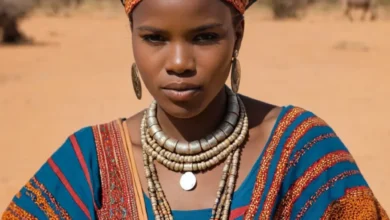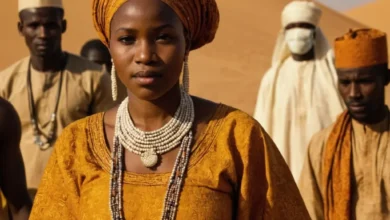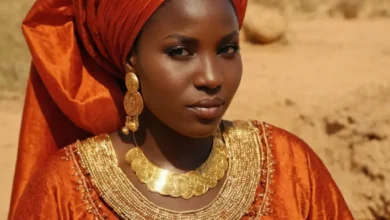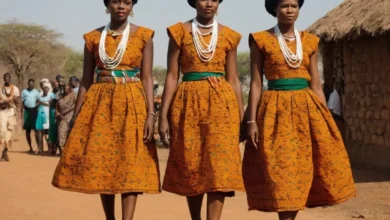Kenyan Traditional Clothing
Kenya, a vibrant nation nestled in East Africa, is renowned for its stunning landscapes, abundant wildlife, and rich cultural tapestry. Woven into the fabric of Kenyan society is a vibrant array of traditional clothing, each garment a testament to the country’s diverse tribal heritage and a captivating reflection of cultural identity.
From the bold colors of Maasai attire to the intricate beadwork of the Turkana, Kenyan traditional clothing is not merely fabric; it is an art form, a narrative, and a powerful symbol of heritage.
A Kaleidoscope of Tribes, A Spectrum of Styles
Kenya is home to over 40 different ethnic groups, each with their unique traditions, languages, and distinct styles of dress. These diverse communities have evolved distinct clothing styles over centuries, reflecting their lifestyles, beliefs, and social structures.
Traditional Kenyan garments are not simply articles of clothing; they are a tapestry of stories, beliefs, and social messages. Understanding the significance of these garments provides a window into the heart and soul of Kenyan culture.
See also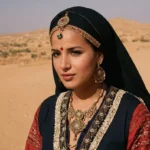 Libyan Traditional Clothing: Adapting to Desert Climate and Cultural Traditions
Libyan Traditional Clothing: Adapting to Desert Climate and Cultural Traditions
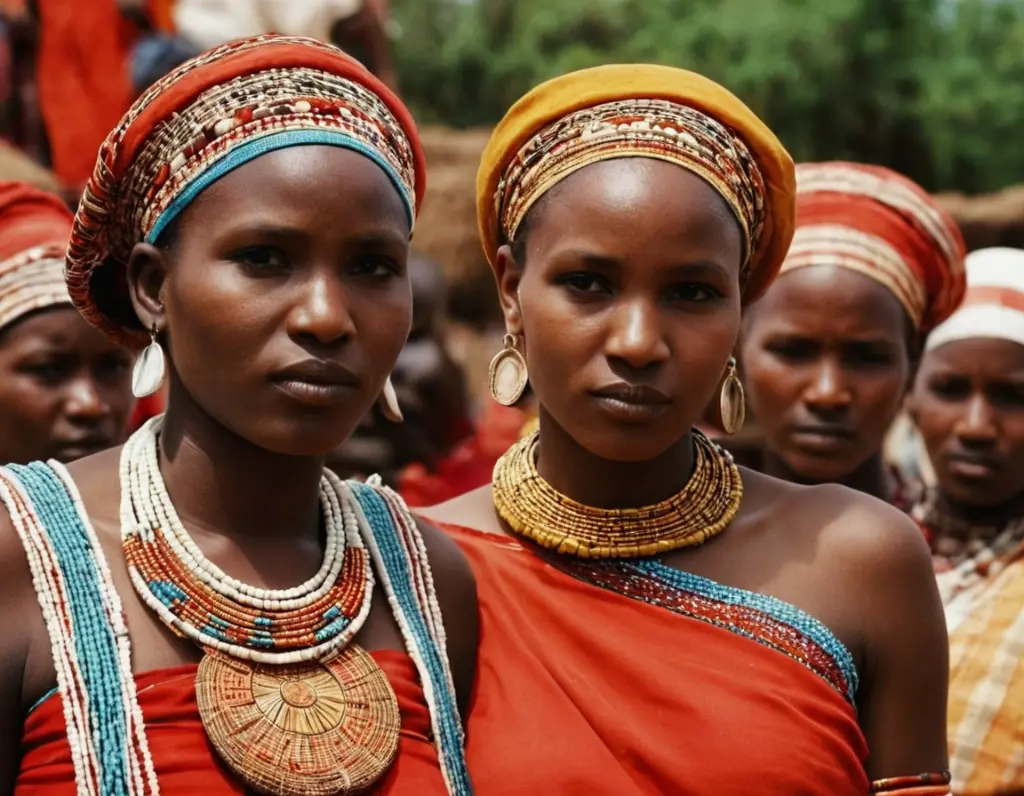
Maasai: Warriors of the Savanna
The Maasai, renowned for their vibrant red attire and intricate beadwork, are one of Kenya’s most iconic tribes. The Maasai are pastoralists, living a nomadic lifestyle on the open savannas, and their clothing reflects their connection to nature and their warrior spirit.
Men typically wear a red shuka (a large cloth wrapped around the waist), often adorned with intricate beadwork and colorful stripes. This symbolizes their strength, courage, and connection to the land. Women adorn themselves with colorful shukas, vibrant beaded jewelry, and elaborate hairstyles, signifying their status, beauty, and fertility.
- Significance of Colors: Red is a dominant color in Maasai attire, representing the blood of their cattle, which are central to their livelihood. Blue is often used for ceremonial purposes, symbolizing the sky and the divine.
- Beadwork: The intricate beadwork adorning Maasai clothing carries deep cultural significance. Each pattern and color has a specific meaning, often conveying the wearer’s age, marital status, or social standing.
- Headwear: Maasai men often wear a headpiece called a kanga, adorned with feathers and beads. These are symbols of status and signify the wearer’s age and accomplishments.
Kikuyu: The Farmers of Central Kenya
The Kikuyu people, known for their agricultural prowess and close-knit communities, have a distinct clothing style that reflects their connection to the land and their agricultural traditions. The Kikuyu women’s traditional dress, known as a kiemba, is a long, colorful wrap-around skirt. It is often adorned with intricate patterns and symbolizes the woman’s fertility and role as the backbone of the community. Kikuyu men traditionally wear a short tunic called a kanzu and a shawl called a kanga, signifying their status and responsibility as protectors and providers.
- Significance of Colors: The vibrant colors of Kikuyu clothing often reflect the colors of the land, reflecting their deep connection to nature and the cycle of planting and harvesting.
- Kanga Patterns: The intricate patterns on the kanga, a cloth worn by both men and women, often depict proverbs, stories, or symbols that convey messages about life, love, and societal values.
- Ceremonial Dress: For special occasions, the Kikuyu people wear elaborate clothing adorned with intricate embroidery and beadwork, reflecting the rich cultural heritage and artistic traditions of the community.
Turkana: The People of the Arid North
The Turkana, a nomadic pastoral community living in the arid regions of northern Kenya, have a unique style of clothing that reflects their resilience in a harsh environment. Their clothing is characterized by earthy tones, simple designs, and practicality.
See also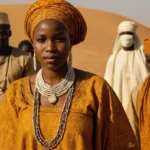 Malian Traditional Clothing: The Rich Textiles and Styles of West Africa
Malian Traditional Clothing: The Rich Textiles and Styles of West Africa
Turkana men traditionally wear a long, rectangular piece of cloth called a shuka, draped over the shoulder and fastened at the chest, providing protection from the sun and wind. Women often adorn themselves with colorful beads, leather belts, and necklaces, signifying their status and beauty.
- Shuka: The shuka, a staple of Turkana attire, is both a practical garment and a symbol of identity. It can be used for warmth, shelter, and as a carrying cloth for belongings.
- Beadwork: Turkana beadwork is known for its intricate patterns and vibrant colors. The beads are often made from recycled materials like bottle caps and plastic, showcasing the community’s resourcefulness.
- Leather Ornaments: Leather belts, necklaces, and bracelets are commonly worn by both men and women, representing their social standing and cultural identity.
Beyond the Fabric: The Deeper Meaning of Kenyan Traditional Clothing
Beyond the intricate designs and vibrant colors, Kenyan traditional clothing carries a deeper meaning, reflecting the cultural beliefs, values, and social structures of each tribe. These garments are not just items of dress but are integral parts of everyday life, ceremonies, and rituals.
A Symbol of Identity and Heritage
Kenyan traditional clothing is a powerful symbol of identity and heritage. By wearing these garments, people reaffirm their connection to their tribe, their history, and their cultural values. The clothing serves as a visual reminder of their ancestors and the legacy they carry. It fosters a sense of pride and belonging, uniting individuals within their community.
A Narrative of Social Status and Roles
Traditional clothing often signifies the wearer’s social status, age, and role within the community. The intricate beadwork, colors, and patterns can convey information about marriage, wealth, or tribal affiliation. For example, a Maasai woman’s beaded necklaces and jewelry often indicate her marital status and her family’s wealth.
Ceremonial and Ritualistic Significance
Traditional clothing plays a crucial role in ceremonies, rituals, and special occasions. During weddings, initiations, and funerals, specific garments are worn to represent the significance of the event and to pay respect to tradition. The clothing often symbolizes the transition into new stages of life or marks significant moments within the community.
The Future of Kenyan Traditional Clothing
In a rapidly changing world, Kenyan traditional clothing faces challenges, but it also has a bright future. The younger generation, while embracing modern styles, also recognizes the importance of preserving their cultural heritage. This has led to a resurgence of interest in traditional clothing, and efforts are underway to promote and revitalize these art forms.
Modern Interpretations and Fusion
Modern Kenyan designers are creatively reimagining traditional styles, incorporating modern fabrics and techniques while maintaining the essence of cultural heritage. This fusion of traditional and modern styles reflects the dynamism of Kenyan culture and its ability to adapt and evolve. By blending the past and the present, these designers ensure that traditional clothing remains relevant and appealing to younger generations.
Promoting Cultural Preservation
There is a growing awareness of the importance of preserving Kenyan traditional clothing. Organizations, artisans, and designers are working to document, promote, and revitalize these unique art forms. Through workshops, exhibitions, and educational programs, they are sharing the stories behind the clothing and inspiring younger generations to embrace their cultural heritage.
A Source of Economic Empowerment
Kenyan traditional clothing also holds significant economic potential. By supporting local artisans and designers, we can create jobs, empower communities, and promote sustainable economic development. The tourism sector can also benefit from the promotion of traditional clothing, attracting visitors who are eager to experience the rich cultural diversity of Kenya.
Frequently Asked Questions (FAQs)
What are the most popular types of traditional clothing in Kenya?
The most popular types of traditional clothing in Kenya include the shuka (worn by the Maasai, Turkana, and other tribes), the kanga (a cloth worn by both men and women), and the kiemba (a long skirt worn by Kikuyu women). These garments are not only culturally significant but are also widely used in everyday life.
Where can I find traditional Kenyan clothing?
You can find traditional Kenyan clothing in various markets, craft villages, and souvenir shops throughout the country. You can also purchase them online from retailers specializing in African clothing. It is important to look for authentic garments made by local artisans and designers to support the local economy.
Is it appropriate to wear traditional clothing in Kenya?
Wearing traditional Kenyan clothing is generally considered respectful and appreciated. However, it is important to be mindful of cultural sensitivities and to dress appropriately for the occasion. It is a good idea to research the specific customs and traditions of the tribe whose clothing you are considering wearing.
Kenyan traditional clothing is a captivating testament to the country’s rich cultural diversity. It is a vibrant expression of heritage, identity, and the interconnectedness of human experience. The intricate designs, vibrant colors, and deeper meanings embedded within these garments provide a window into the lives, beliefs, and values of the Kenyan people.
As we celebrate the beauty and significance of Kenyan traditional clothing, we also acknowledge the importance of preserving these art forms for future generations. By promoting cultural understanding, supporting local artisans, and embracing the dynamism of Kenyan culture, we can ensure that the stories woven into the fabric of traditional clothing continue to inspire and connect us all.
